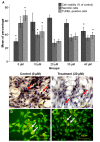Neuroprotective effects of selegiline on rat neural stem cells treated with hydrogen peroxide
- PMID: 29399337
- PMCID: PMC5772055
- DOI: 10.3892/br.2017.1023
Neuroprotective effects of selegiline on rat neural stem cells treated with hydrogen peroxide
Abstract
Oxidative stress and reactive oxygen species generation have been implicated in the pathogenesis of several neurological disorders including Parkinson's disease, Alzheimer's disease, amyotrophic lateral sclerosis and multiple sclerosis. In the present study, the neuroprotective effects of selegiline against hydrogen peroxide-induced oxidative stress in hippocampus-derived neural stem cells (NSCs) were evaluated. NSCs isolated from neonatal Wistar rats were pretreated with different doses of selegiline for 48 h and then exposed to 125 µM H2O2 for 30 min. Using MTT and terminal deoxynucleotidyl transferase-mediated dUTP nick end labeling assays, acridine orange/ethidium bromide staining and reverse transcription-quantitative polymerase chain reaction, the effects of selegiline on cell survival, apoptosis and the expression of B-cell lymphoma 2 (Bcl-2) and heat shock protein 4 (Hspa4) in pretreated stem cells were assessed compared with a control group lacking pretreatment. The results indicated that the viability of cells pretreated with 20 µM selegiline was significantly increased compared with the control group (P<0.05). Additionally, 20 µM selegiline increased the mRNA expression of Bcl-2 and Hspa4 (P<0.05 vs. control) and suppressed oxidative stress-induced cell death (apoptosis and necrosis; P<0.05 vs. control and 10 µM groups). From these findings, it was concluded that selegiline may be a therapeutic candidate for the treatment of neurological diseases mediated by oxidative stress.
Keywords: B-cell lymphoma 2; heat shock protein 4; neural stem cells; oxidative stress; selegiline.
Figures



References
LinkOut - more resources
Full Text Sources
Other Literature Sources
Miscellaneous
